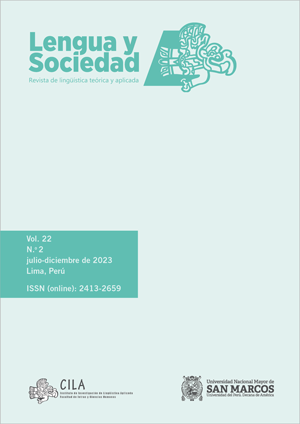Elogio de la madrastra: cohesión y coherencia entre lo textual y lo textil
DOI:
https://doi.org/10.15381/lengsoc.v22i2.24634Palabras clave:
cohesión, coherencia, erotismo, texto, textilResumen
La novela erótica Elogio de la madrastra, de Mario Vargas Llosa (1998), consta de catorce capítulos y un epílogo. Seis de los capítulos abren con cuadros de artistas clásicos (cuatro de ellos de los siglos XV al XVI, y dos del XX). Sin embargo, las imágenes no constituyen una ayuda visual para entender la trama, sino que forman parte de ella; es decir, las situaciones vividas por los personajes se reflejan en las pinturas. Los personajes prolongan su fantasía erótica en los cuadros y los personajes de los cuadros cobran vida. A través de los conceptos de cohesión y coherencia de la lingüística del texto, explicamos que lo textual y lo textil (lienzo) en la novela se cohesionan y forman una trama coherente.
Referencias
Agudelo, P. A. (2013). Écfrasis literaria y arquitectura novelesca: Los cuadernos de don Rigoberto de Mario Vargas Llosa. Perífrasis. Revista de Literatura, Teoría y Crítica, 4(7), 115-131. https://doi.org/10.25025/perifrasis20134708
Arellano García, P. y Díaz Blanca, L. (2008). Proyectos Pedagógicos de Aula: estructura textual y mecanismos de cohesión. Opción, 24(56), 124-142. https://redalyc.org/pdf/310/31045608.pdf
Bobes Naves, M. C. (2018). El personaje literario en el relato. Consejo Superior de Investigaciones Científicas.
Casalmiglia Blancafort, H. y Tusón Valls, A. (1999). Las cosas del decir. Manual de análisis del discurso. Editorial Ariel. Calsamiglia%20y%20Tuson%20-%20Las%20cosas%20del%20decir.%20Manual%20de%20analisis%20del%20discurso.pdf
Enkvist, N. E. (1985). Text and Discourse Linguistics, Rhetoric and Stylistics. En T. A. van Dijk (Ed.), Discourse and Literature (pp. 11-38). John Benjamins Publishing Company.
Esparza Torres, M. Á. (2006). Pautas para el análisis de la cohesión y la coherencia en textos españoles. Rilce, 22(1), 59-89. https://hdl.handle.net/10171/6720
Foucault, M. (2019). Historia de la sexualidad I: La voluntad del saber (trad. U. Guinazú). Siglo XXI de España Editores. (Obra original publicada en 1976).
Foucault, M. (2010). Las palabras y las cosas (Trad. E. C. Frost). Siglo XXI Editores. (Obra original publicada en 1968).
García-Bedoya, C. (2019). Hermenéutica literaria. Una introducción al análisis de textos narrativos y poéticos. Editorial Cátedra Vallejo.
Giraldo, E. (2011). Elogio de la madrastra de Mario Vargas Llosa, obra de arte total, límites y vecindades. Co-herencia, 8(15), 239-268. https://scielo.org.co/pdf/cohe/v8n15/v8n15a10.pdf
López Samaniego, A. (2014). Las etiquetas discursivas: cohesión anafórica y categorización de entidades del discurso. Ediciones Universidad de Navarra.
Marting, D. E. (1998). Concealing Peru in Mario Vargas Llosa’s “Elogio de la Madrastra”. Chasqui: revista de literatura latinoamericana, 27(2), 38-53. https://www.jstor.org/stable/29741436
Valdivia Baselli, A. (2005). Ekphrasis como traducción visual y correspondencias literarias en el lenguaje pictórico desde «Museo interior» de José Watanabe. Ajos & Zafiros. Revista de Literatura, (7). https://repositorio.unmsm.edu.pe/handle/UNMSM/1344
van Dijk, T. A. (1978). Cognitive processing of literary discourse [Ponencia]. Coloquio Internacional sobre Poética, Semiología y Teoría de la Significación, Universidad Autónoma, Ciudad de México (21-25 de agosto), y en el Coloquio Internacional La Investigación Lingüística del Texto Literario, Málaga (13-17 de noviembre). https://discourses.org/wp-content/uploads/2022/07/Teun-A.-van-Dijk-1979-Cognitive-processing-of-literary-discourse.pdf
van Dijk, T. A. (1980). Estructuras y funciones del discurso. Una introducción interdisciplinaria a la lingüística del texto y a los estudios del discurso (Trad. M. Gann). Siglo XXI.
Vargas Llosa, M. (1999). Elogio de la madrastra. Peisa. (Obra original publicada en 1988).
Descargas
Publicado
Número
Sección
Licencia
Derechos de autor 2023 Katherine Pajuelo Lara

Esta obra está bajo una licencia internacional Creative Commons Atribución 4.0.
LOS AUTORES RETIENEN SUS DERECHOS:
a. Los autores retienen sus derechos de marca y patente, y también sobre cualquier proceso o procedimiento descrito en el artículo.
b. Los autores pueden presentar a la revista Lengua y Sociedad, trabajos difundidos como pre-print en repositorios. Esto debe hacerse conocer en la carta de presentacion del trabajo.
c. Los autores retienen el derecho de compartir, copiar, distribuir, ejecutar y comunicar públicamente el artículo publicado en la revista Lengua y Sociedad (por ejemplo, colocarlo en un repositorio institucional o publicarlo en un libro), con un reconocimiento de su publicación inicial en la revista Lengua y Sociedad.
d. Los autores retienen el derecho a hacer una posterior publicación de su trabajo, de utilizar el artículo o cualquier parte de aquel (por ejemplo: una compilación de sus trabajos, notas para conferencias, tesis, o para un libro), siempre que indiquen su publicación inicial en la revista Lengua y Sociedad (autores del trabajo, revista, volumen, número y fecha).






